Petra, Jordan
Letter #37: Yet another place I did very little research on and turned out to be a new crowd favorite.
5/21/23
When Kathy and Yasmin asked what I wanted to do during my month long visit to Palestine, I didn’t have anything specific in mind with the exception of a trip to Jordan. This is something Hilary has been talking about doing for years—see Petra. I googled some images but other than that I didn’t read much about the history or what to see. Kathy had been several times so I figured she’d know how to pull it off.
I was surprised when Yasmin told me there would be 8 of us family members going. I haven’t traveled with that big of a group in years, and I knew it would be fun to explore another Arab country with my native-speaking family members.
Tawfik had made the travel arrangements for us, using a good friend of his that is a travel agent. I wasn’t even aware we used an agent! I asked very few questions outside of what kind of clothing to pack, and whether or not I should keep my hair covered out of respect. I also hadn’t taken a trip arranged by a travel agent in years! Not since my dad helped me book a trip to Mexico back in 2005, through one of his clients that worked off of trade of services.
We piled into two cars and headed down to the border of Israel, near Eilat. This is an interesting part of the country—along the east you have the Dead Sea, which is 421 meters below sea level, being the lowest place on earth. The water is 10 times saltier than ocean water, so you will not find plants or any sort of sea life in the water. The hills and canyons of the Negev desert had been formed so long ago I won’t even try to look up the dates 🤣 but you could nearly imagine how this land used to be covered by water until plate tectonics changed the water levels, and land rose to the surface, leaving the Dead Sea completely landlocked. Kathy warned me though, that if I already thought the landscape of the Negev was fascinating, just wait until we reach Jordan—the colors alone are breathtaking.
I was under the impression we’d drive our cars into Jordan, past border patrol, but I was wrong. Kathy explained that it would be too much of a hassle to bring the cars back over the border, through the Israeli agents. As it stands, I could face some questioning anyways when we entered back into the country. So we ditched our cars in the parking lot outside the gate and walked our luggage over the border. Getting into Jordan was little trouble for my Arabic-speaking family. The text on every sign switched to Arabic, and there was a welcome feeling from the guards. The crossing took about 10-15 minutes. We hired two taxis once we got through the gate and headed towards our hotel in Aqaba.
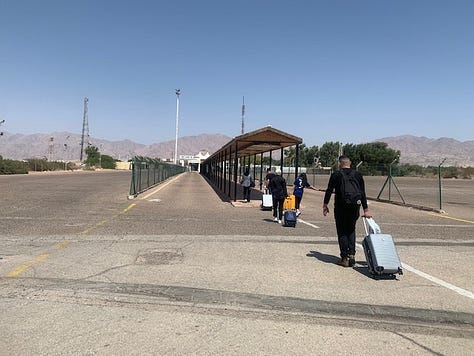
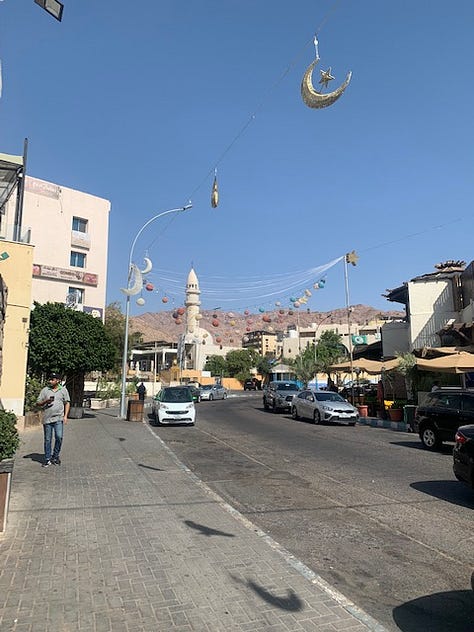

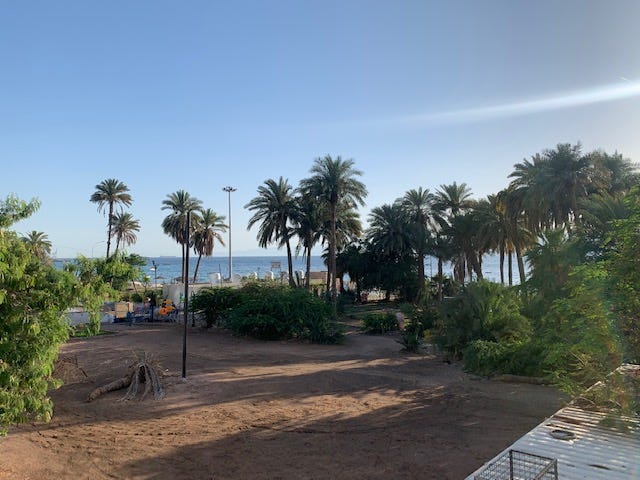
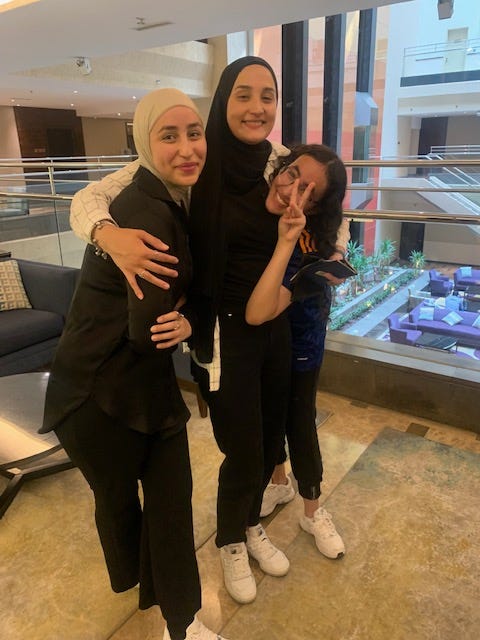

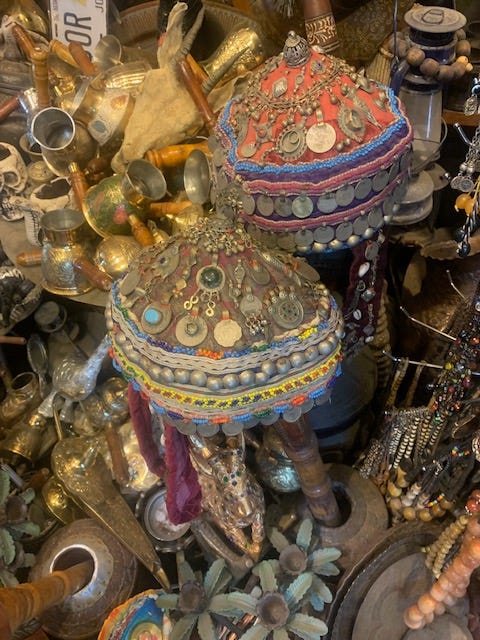
Aqaba is Jordan’s main port city, set along the Red Sea, right next to Eilat. On one of the higher hilltops in the city, you can spot both Israel and Egypt in its view. I would’ve imagined a port city to be much larger, but it was relatively small and charming. We dropped our luggage and headed out in search of the city’s best shawarma.
Luckily, the family’s cousin, Ziad, comes to Aqaba all the time, so he had plenty of recommendations for us. We picked a hole-in-the-wall takeout spot and chowed down—YUM. I had been craving a chicken gyro so this place hit the spot. Then we walked around looking for the best sweets—again Ziad had steered us in the right direction. We ordered two types of knafe and split them.
We walked around the market for a bit, then headed back to the hotel for a rest. The next day we’d be heading to Petra early in the morning. It would take us about 2 hours to drive there, 2 hours to walk to the treasury, and then another 2 hours of driving back to Aqaba—a long travel day.
Kathy and I shared a room at the hotel, and it was nice to get some solo time with her. I had been living very comfortably with this side of my family the past week and a half, and since I don’t see the rest of my extended family much, it was great to growing my relationships here.
We next morning we grabbed a hotel breakfast and walked outside to catch our ride to Petra. I began cracking up when I saw the small tour bus waiting out front—the family had gone all out! I assumed we’d cram ourselves into a 15 passenger van, but quite the contrary! We had plenty of room to spread out and enjoy the ride.
Kathy narrated the scenery of the drive for me, noting the Bedouin villages along the way, and even pointing out some traditional goat hair tents that the Bedouin live in while following their grazing herds through the desert. Ismael’s mother used to make these goat hair tents by hand for her family. The varying colors of sand changed from white to yellow to pink and to red along the way.
I’d never been somewhere like this before. There was very little vegetation with the exception of some hearty desert shrubs that could withstand the lack of water. There were flash flood warning signs along the road—on the rare occasion it should rain, the ground is so dry and packed, there is nowhere for the rain water to go. Flooding occurs quickly, rising without warning and washing everything away in its path.
We passed a huge wind turbine farm as we reached higher elevation, which I hadn’t see since I visited Palm Springs, California back in 2017. Jordan has four wind farms producing energy for the country. It is not a wealthy country, with fewer natural resources, and lacking the fossil fuels of its neighbor, Saudi Arabia.
The Turkish railroad, Hejaz, ran perpendicular to the road, weaving in and out of mountainous red and pink stones that rose out of the sand. The railway was built during the time when the Turkish Ottoman Empire ruled over Arab lands, and was meant to connect Istanbul all the way to Mecca for political and economic advantages. The railway was never fully completed, reaching up only until Medina as World War I broke out.
The family here loves Turkey, despite the late Ottoman Empire ruling—AND Jordan. Both countries are very welcoming of the Arab culture. Israeli citizens are very limited by where they can travel in the Middle East due to the ongoing crisis that began with Zionism back in the late 1800s, and later escalating to Al Nakba of 1948. And even though my family are Palestinians, they hold Israeli passports, and therefore cannot pass into many countries where Israel is not a friend of the Arab community.
It was sad to see how frustrating travel can be for them, and also how frustrating it can sometimes be for them to continue to live in their homeland of Palestine.
But Jordan was a short of refuge for everyone. I could how happy they were, some of the tension leaving as they could move more freely here, without judgement. All the signs and menus were in Arabic, and many of the women wore hijabs or niqabs to cover their hair, long thobes to cover their bodies. The men in long, white cotton dishdashah robes with white and red checkered keffiyehs tied around their heads, held on by a black rope called an agal. My family was incredibly welcomed at every restaurant we vistied, and it was great to experience the same hospitality they had shown me at home, out in public. If it were me, I’d be very tempted to relocate my life to Jordan, where I felt accepted and could live without fear. But the heartache of leaving the land their ancestors have lived on for many generations runs too deep, and so Palestine remains home, even under an oppressive occupation.
Could everyone live peacefully among one another? Sure, I think they could. But you’d have to remove the extreme nationalistic, Zionistic mindset that is actively seeking to ethnically cleanse the Holyland.
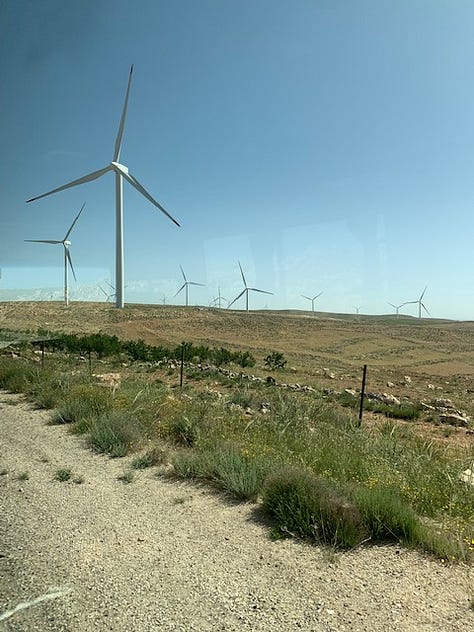


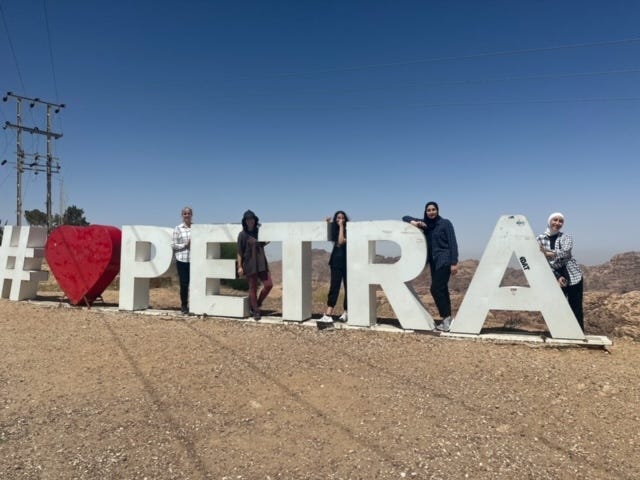
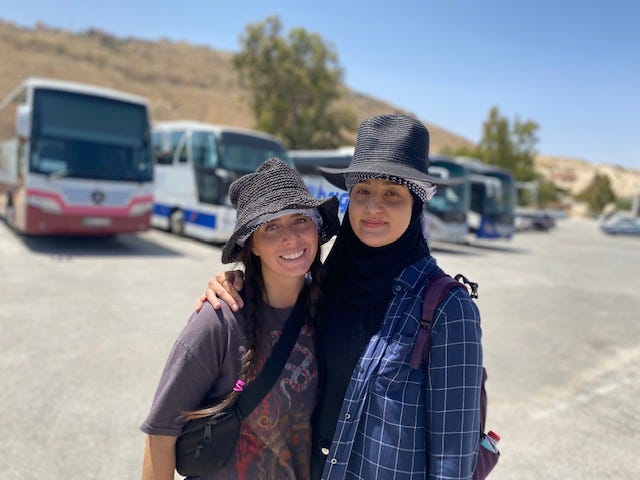
Back to Jordan…when we reached the valley of Petra, a tour guide met us to take us down to the treasury. He was walking as slow as an old mule, leading the tour in Arabic only, so my cousins and I walked ahead, taking pictures and chatting. We’d catch the cliff notes later.
The path down to the treasury leads through towering sandstone walls, the colors in streaks of vivid clay reds and pinks, the sand packed down over thousands upon thousands of years of weather and erosion, plate tectonics, floods, and volcanic activity.
The Nabataeans were an Arab tribe that inhabited Petra as far back as 600 B.C., although the land saw inhabitants as early as 7000 B.C. The valley became an important stop along the trade route from Asia to Africa and Europe. The Nabataeans grew very rich from the fees they charged for the goods carried across this key city—as much as 1/4 the price of the goods being traded. They devised ways of capturing the rainwater in aqueducts that allowed them to sustain the growing population residing there, as well as the caravans traveling through. Frankincense and myrrh were among the most valuable commodities being traded by the Nabataeans in the region during that time, along with gold and silver. Incense was used by royalty and the wealthy elite to help cover the stink of these newly formed cities where proper sewage infrastructure and daily bathing had yet to be established. It was also widely used for religious purposes.
As the Nabataeans wealth grew, they began to further establish their city, carving out the facade of the Treasury, or Al Khazna, directly into the mountainous wall around the 1st century A.D. The monument acted as a mausoleum for royalty, but was later named a treasury as the Bedouins believed it may house royal treasures.
The Nabataeans wealth and power came to an end after being conquered by the Romans in 106 A.D., and later wiped out by a massive earthquake in 363 A.D. that damaged their valuable aqueduct, and thus water source, beyond repair. Somehow the treasury remained standing, demonstrating the genius of the engineering back then.
Seeing Petra in person was truly remarkable, again, like any other place I’d visited before. After passing through a path whose sandstone walls arch over the passageway, towering so high they nearly block out the sky, the treasury emerges just as you enter a clearing. How long it must’ve taken the Nabataeans to build this perfectly symmetrical facade into the sandstone is beyond imagination.
We took thousands of photos, enjoying our time down in the valley. The one downside? It was completely overrun by tourists. The photos you see online are not what it’s like in person. It felt loud and crowded, young high schoolers shrieking and blasting loud music to impress their friends (yes, I was totally like that, too, as a teenager). Timed entrances would’ve done this place some justice. I’m overly sensitive to lines and crowds so I have a hard time enjoying myself when something so beautiful feels spoiled by something as unnatural as hordes of tourists—even if one of those tourists is me.
We headed back to the entrance, hiking a bit faster to get out of the late morning heat as soon as possible. Yasmin and I kept pace together and enjoyed some solo time to talk. Tishreen hired a horse to take her back, which looked fun, but I was desperate to turn this into a workout in order to combat all the amazing Palestinian dishes I’d been indulging in over the past couple weeks.
We grabbed lunch in the city of Petra, all of us tired, dusty, and sweaty from hiking in the desert sun. We hopped on the bus and headed back to Aqaba, Tishreen DJing for us with some jamming Arabic beats. I knew none of the lyrics, but I clapped along with the rest of the fam—they know how to make a party bus! (Hold the booze).
We ate dinner at an outdoor cafe that night, the weather being so pleasant in the desert in the evening. The air grew cooler, with a soft breeze, and we people watched as everyone was enjoying the city nightlife. Around 10pm we headed back to the hotel—we had a leisurely morning ahead of us tomorrow, as our Wadi Rum tour wouldn’t begin until 3:30pm.

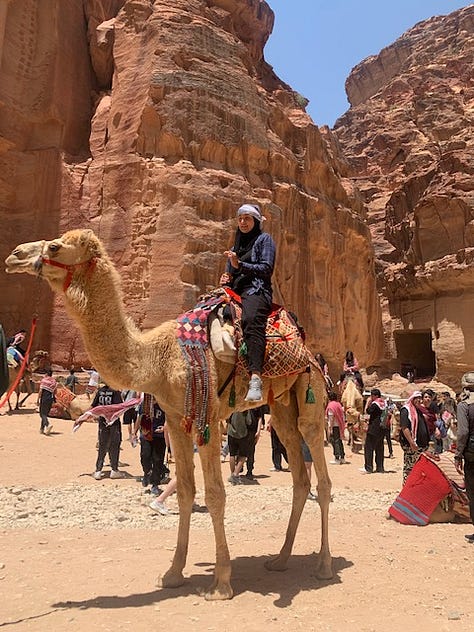
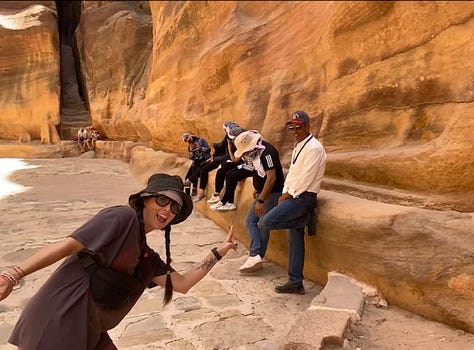

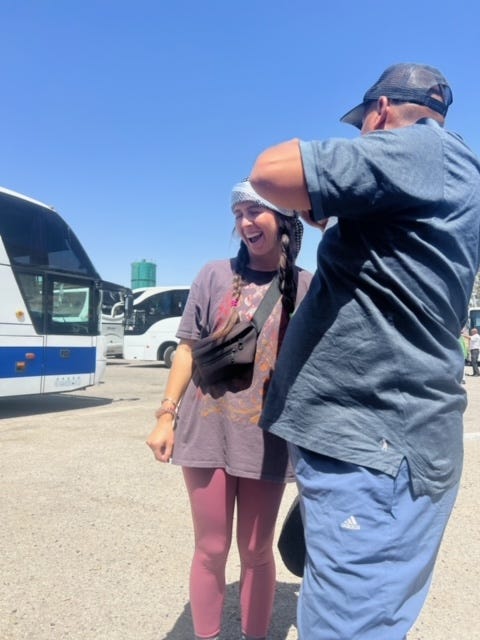
PODCAST: Ok I didn’t get ANY of my info about the Nabataeans from the tour guide. My dear friend, Lars, sent me a podcast, The Fall of Civilizations, that chronicled the rise and fall of the Nabataean people. He said Ally hated listening to these 2 hour long podcast episodes where the host speaks in a monotone voice for the entire time—which is exactly the reason why he loves them. 🤣 Normally, I’d agree with Ally, except that I was curious to learn more about this place so I split the podcast between two runs, and thus had enough info to share with all of you.
Hey! Would you like to connect over creativity, self-growth, and problem-solving? Or just to have a virtual glass of wine or mocktail? Please book a time on my Calendly for us to chat! I can’t wait to see you. XOXO.
If you’re enjoying On the Road, please share with others who you may think would enjoy as well! As always, I love reading your comments and feedback. If you're not already subscribed, please click the button below so I can continue sending you weekly-ish stories and lessons while I travel. 🚙

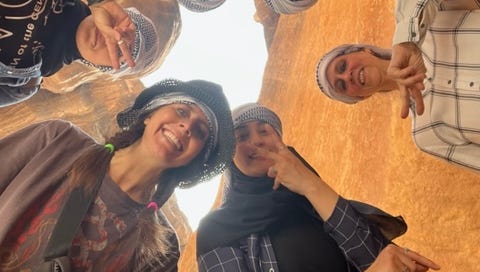




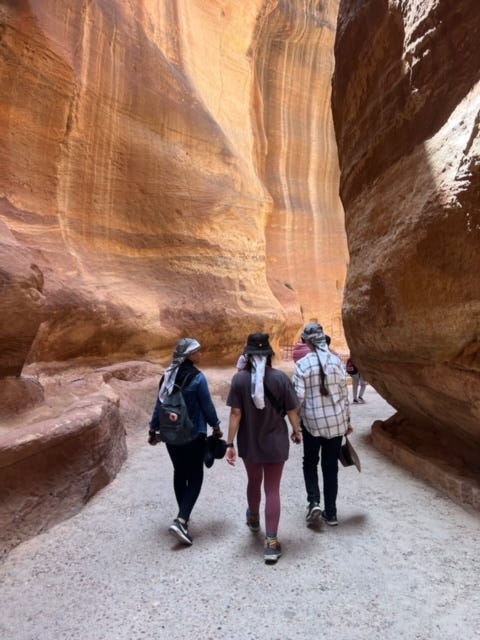
I also listened to that podcast on my work commute to and from Tel Aviv, and learned a lot!! Thanks, Lars and Paul Cooper 🙏🏽.
Shout out to Paul Cooper for one of my favorite podcasts!